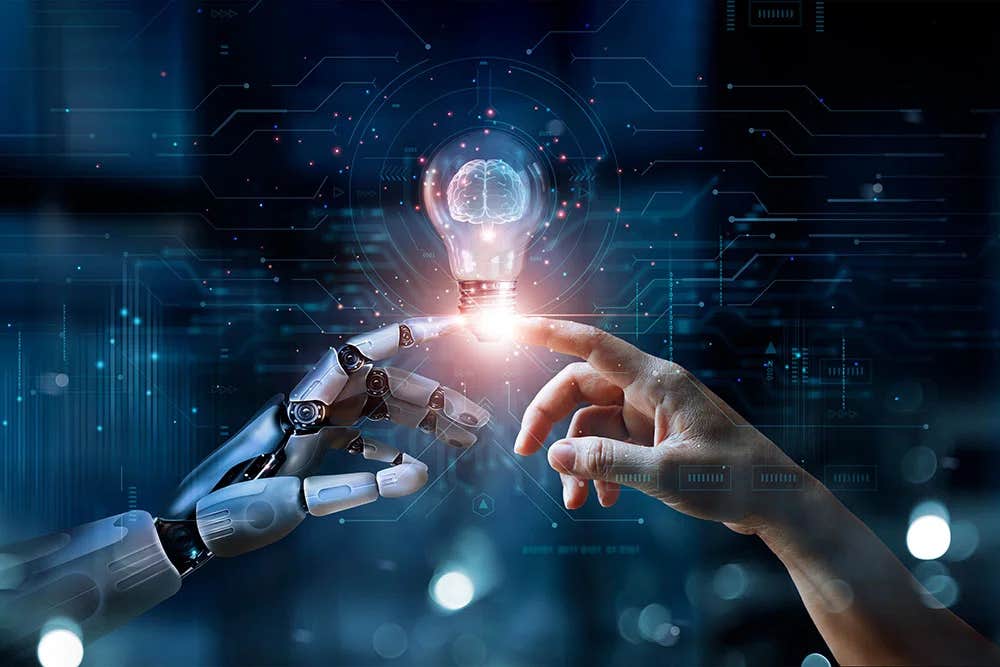Do humans and AI work better together or alone? Surprising MIT findings
MIT study reveals when human-AI collaboration excels and where it falls short, urging organizations to rethink AI’s role in creative and decision-making tasks.

Uncovering the true potential of human-AI collaboration. (CREDIT: CC BY-SA 3.0)
A new study from the MIT Center for Collective Intelligence (CCI) is redefining the landscape of human-AI collaboration.
The report, published in Nature Human Behaviour, unveils findings that add nuance to our understanding of when human-AI partnerships can truly excel. Conducted by CCI affiliate Michelle Vaccaro and MIT Sloan School of Management professors Abdullah Almaatouq and Thomas Malone, the study raises thought-provoking questions about AI’s role in today’s workplace and beyond.
For years, the vision of human-AI synergy has driven organizations to integrate AI into processes, assuming it would enhance performance across the board. However, this comprehensive analysis of 370 different outcomes from 106 experiments reveals a more complex picture. Rather than proving universally beneficial, human-AI collaboration sometimes falters, especially in decision-making tasks.
However, the study found these partnerships often shine in creative pursuits, indicating potential for future applications that prioritize human ingenuity alongside AI’s technical prowess.
Human-AI Partnerships: When They Work Best
Using data from experiments conducted between 2020 and 2023, the researchers set out to determine whether combining humans and AI would lead to “synergy”—meaning a partnership where humans and AI outperform either working alone. The results were surprising: while human-AI teams generally surpassed human-only performance, they often fell short of AI alone, indicating that synergy doesn’t emerge as easily as anticipated.
The research shows clear boundaries where human-AI collaboration can be useful. For decision-making tasks, such as identifying deep fakes, forecasting demand, or diagnosing medical conditions, AI on its own often achieved better results than human-AI teams.
Related Stories
This finding challenges the widely held belief that AI integration naturally enhances results. “There’s a prevailing assumption that integrating AI into a process will always help performance—but we show that that isn’t true,” Vaccaro explained. “In some cases, it’s beneficial to leave some tasks solely for humans, and some tasks solely for AI.”
However, in tasks requiring creativity, human-AI partnerships showed promise. For example, the study found that collaborative efforts between humans and AI yielded positive outcomes in tasks like summarizing social media posts, generating answers for chat queries, and producing new content, including imagery.
“AI has mostly supported decision-making in recent years, analyzing data and offering predictions,” Malone noted, “but some of the most promising opportunities for human-AI combinations now are in supporting the creation of new content, such as text, images, music, and video.”
Creativity Over Calculation
The advantage of combining humans and AI in creative tasks likely stems from the dual nature of these assignments. Creative endeavors require human intuition, imagination, and cultural knowledge—qualities that AI alone lacks. But these tasks also involve repetitive and complex processes, areas where AI shines.
By blending human creativity with AI’s efficiency, these collaborations allow each party to contribute their best skills. As an example, designing an image may require artistic inspiration—a human strength—alongside detailed execution, which is a task well suited for AI.
Vaccaro emphasized that the research underscores the need for more intentional thinking in implementing human-AI partnerships. “The effectiveness is not necessarily about the baseline performance of either of them, but about how they work together and complement each other,” she said. This insight encourages organizations to reconsider the blanket adoption of human-AI collaborations and focus on areas where these partnerships add clear value.
Practical Recommendations for Organizations
For businesses and institutions eager to integrate AI effectively, this research offers practical guidance. The team suggests three main actions for organizations considering human-AI collaborations. First, companies should measure their current systems’ effectiveness to ensure that AI integration is actually enhancing, not hampering, performance.
As Vaccaro explained, “Many organizations may be overestimating the effectiveness of their current systems. They need to get a pulse on how well they’re working.”
Next, organizations should consider which tasks could benefit most from AI’s capabilities, especially those that involve creative work. In tasks like generating marketing materials or summarizing customer feedback, AI could play a valuable role, freeing human workers to focus on more complex aspects of these assignments. Such strategic alignment could unlock new levels of productivity, especially in industries where repetitive tasks could be automated without losing the human touch in decision-making.
Finally, the study stresses the importance of setting clear guidelines and establishing guardrails for AI integration. By crafting processes that play to each party’s strengths, organizations can ensure balanced and effective partnerships. For example, companies could leverage AI for data-heavy tasks like pattern recognition and predictions while reserving human input for tasks requiring nuanced judgment and context.
As Malone put it, “Let AI handle the background research, pattern recognition, predictions, and data analysis, while harnessing human skills to spot nuances and apply contextual understanding.” In other words, he advised, “Let humans do what they do best.”
The Challenges and Opportunities Ahead
This MIT-led study sheds light on the persistent challenges of human-AI collaboration, such as communication issues, trust concerns, and the need for effective coordination. These obstacles can impede the seamless integration of human and AI capabilities. Vaccaro and her team identified that synergy is not as simple as combining two different strengths; it requires carefully calibrated partnerships and structures to optimize their collaboration.
The search for true synergy in human-AI collaborations isn’t new, but it’s gaining traction. The potential of human-AI partnerships has been explored in healthcare, customer service, and scientific research, with mixed outcomes. As Malone noted, “As we continue to explore the potential of these collaborations, it’s clear that the future lies not just in replacing humans with AI, but also in finding innovative ways for them to work together effectively.”
Where Human-AI Partnerships Fall Short
Despite some successful applications, human-AI collaborations still face limitations. In areas where quick, data-driven decisions are necessary, AI alone may often be the more reliable choice. This is particularly relevant in high-stakes fields like healthcare or finance, where AI’s consistency and analytical speed are crucial. The CCI’s findings emphasize the importance of assessing each task individually to understand whether AI, human input, or a blend of the two will yield the best results.
Furthermore, the assumption that AI will always enhance performance ignores critical ethical and practical considerations. Full automation isn’t always feasible, given concerns about legal, ethical, and safety implications. In these cases, human-AI collaborations offer a viable alternative that respects these boundaries while still taking advantage of AI’s strengths.
While the study highlights areas where human-AI synergy remains elusive, it also identifies promising opportunities in creative fields where collaboration can be more fruitful. The insights gathered by the MIT team challenge companies to look beyond the simplistic notion of AI as a universal solution.
Instead, the study encourages a more thoughtful approach that leverages AI where it can truly add value, complementing rather than replacing human input. In doing so, organizations can harness AI’s power without sacrificing the unique talents that humans bring to the table.
Note: Materials provided above by The Brighter Side of News. Content may be edited for style and length.
Like these kind of feel good stories? Get The Brighter Side of News' newsletter.



